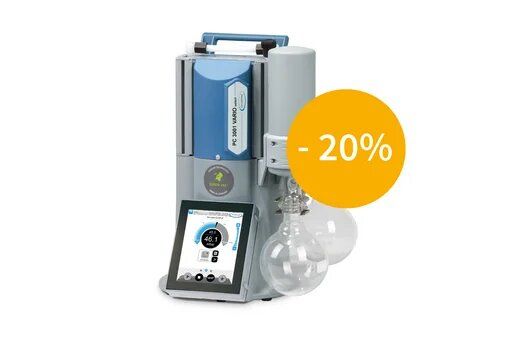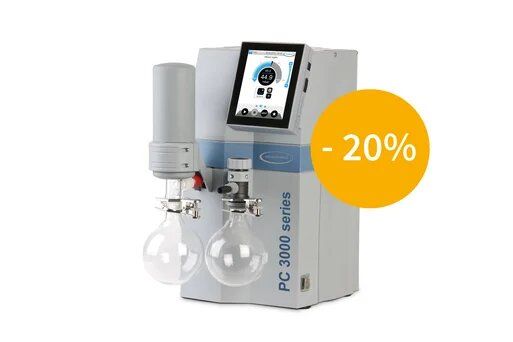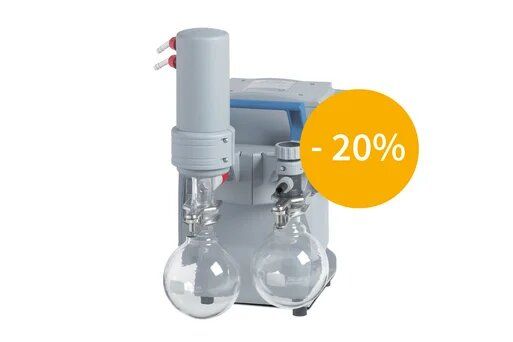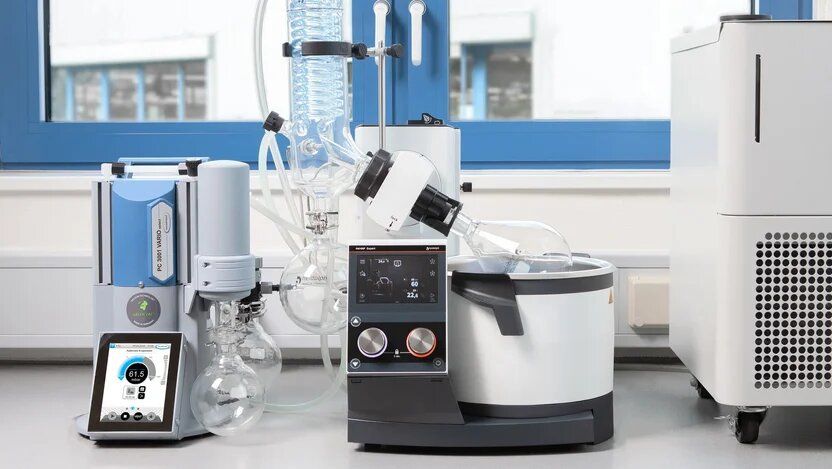Save 20% now: Get your Vacubrand Vacuum Pump for rotary evaporators!
Efficient evaporation starts with the perfect vacuum – and Vacuubrand delivers just that! As a leading manufacturer of chemically resistant vacuum pumps, Vacuubrand offers high-performance solutions ideal for rotary evaporation, ensuring optimum ultimate vacuum and pumping speed tailored to your application. Now available with an exclusive promotional price at Labokraft Kft. from April 1 to June 30, 2025!
Promotional Products




Do you have question or would you like advice?
Vacuum for rotary evaporators
Precise vacuum control is key
Vacuum is the key parameter for successful evaporation, as the temperature cannot be increased at will. Precise vacuum control enables optimum evaporation rates and the shortest process times without bumping or foaming.
Aggressive media are often used. In addition, high levels of vapor can occur. The vacuum pump should therefore have good chemical resistance, high condensate compatibility and sufficient pumping speed. We generally recommend the use of a separator (AK) on the inlet side and an emission condenser (EK) on the outlet side.
VARIO chemistry diaphragm pumps with precise vacuum control and automatic evaporation mode offer the best conditions for processes on rotary evaporators.

Important questions on vacuum technology
Depending on the boiling point of the solvents, an ultimate vacuum in the range between 1 and 10 mbar is sufficient for rotary evaporation. Chemistry diaphragm pumps are best suited for this purpose. They run oil-free and offer excellent chemical resistance and durability.
With classic two-point control, a vacuum valve is switched to keep the vacuum within the target pressure range. VARIO diaphragm pumps control the vacuum precisely via the motor speed. This more precise control leads to optimum evaporation rates and process times. It also makes the pump whisper-quiet, reduces energy consumption and vibration and extends the service life of the diaphragms.
With both two-point control and VARIO control, the VACUU·SELECT controller automatically detects the boiling point of a solvent or several boiling points of a solvent mixture. VARIO diaphragm pumps also offer the option of fully automatic evaporation with boiling pressure adjustment. This means that the pressure at the boiling point is not only maintained, but also automatically adjusted to the process flow. The process runs at optimum evaporation rates, in the shortest possible time and without bumping or foaming. All you have to do is press start and then you can devote yourself to other tasks.
What ultimate vacuum and pumping speed is required?
The ultimate vacuum required by the vacuum pump depends on the boiling points of the solvents used. Higher boiling points require a better ultimate vacuum of the vacuum pump. We recommend the following guidelines:
up to 100 °C, two-stage chemistry diaphragm pumps with 7 mbar ultimate vacuum
up to 150 °C, three-stage chemistry diaphragm pumps with 1.5 or 2 mbar ultimate vacuum
above 150 °C, four-stage chemistry diaphragm pumps with 0.6 mbar ultimate vacuum
The pumping speed is determined by the quantities to be evaporated. The volume of the evaporation flask is a good orientation.
PC 520 select and PC 620 select have a second vacuum port for parallel operation on two rotary evaporators. Each vacuum port has a valve for electronic vacuum control. The integrated vacuum controller VACUU·SELECT regulates the vacuum using two-point control. Both vacuum connections are secured against mutual interference by non-return valves.
An emission condenser (EK) at the outlet enables almost 100 % solvent recovery. A separator (AK) on the inlet side protects the pump by collecting condensate and retaining droplets and particles.
Rotary evaporators and vacuum pumps usually have hose nozzle connections that are connected by a hose.
For cases in which the connection sizes of the pump and rotary evaporator differ, we offer suitable adapters as accessories.
In our Connection Guide you will find everything you need to know about connecting your vacuum pump to a rotary evaporator.